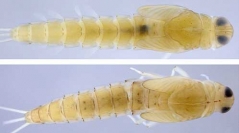

 European Journal of Taxonomy
789 (153) - Pages 153-191
European Journal of Taxonomy
789 (153) - Pages 153-191The original description of Rivudiva trichobasis Lugo-Ortiz & McCafferty, 1998 is short, with few illustrations. The lack of information resulted in a broad specific diagnosis, with emphasis on the spine-like setae on the antenna. Our hypothesis is that the lack of information resulted in many species being hidden behind R. trichobasis name. We evaluated the species R. coveloae (Traver, 1971) and R. venezuelensis (Traver, 1943) considering the new evidence. After analyzing the paratype of R. trichobasis and records of the species in Brazil, the hidden-species hypothesis was corroborated. Five new species were identified among the published records of R. trichobasis of which four are described here: R. amazona sp. nov. (Roraima State), R. oxum sp. nov. (Rondônia State), R. uiara sp. nov. (Amazonas State), R. naia sp. nov. (Roraima State). The fifth species, Rivudiva sp. X from Maranhão State, could not be described due to the poor conservation of the specimen and is therefore left in open nomenclature. Records from Espírito Santo State (Brazil) and from Paraguay are treated as putative and must be evaluated considering the new evidence. Rivudiva venezuelensis and Rivudiva coveloae are diagnosed and illustrated based on type material. After analyzing these two species, we hypothesize that only R. coveloae likely belongs to the genus Rivudiva. However, information on the nymphal stage is needed to corroborate this hypothesis.
Aquatic insect, types, taxonomy, neotropics